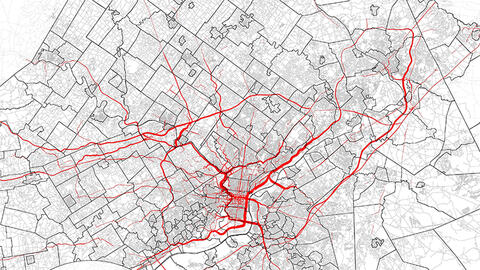
April 28, 2025
DVRPC travel modeling shows the proposed SEPTA service cuts will increase traffic volume and delays, and reduce speed throughout the region. This will impact the quality of life and air quality of our local communities, and have economic impacts felt throughout the Commonwealth.
SEPTA faces a $213 million budget deficit starting July 1, 2025. Without a permanent funding solution, SEPTA will have to raise fares by more than 20% and be forced to take drastic steps to irreversibly shrink the system, including eliminating 50 bus routes and five regional rail lines, reducing service by 20% on all remaining routes, creating a 9:00 p.m. curfew on Metro and Regional Rail routes, and eliminating all special services, such as sports express service to and from the stadiums.
Planning partners across the region are working together to highlight the value of SEPTA service and raise awareness about the impact of the proposed service cuts and fare increases. As part of this effort, DVRPC modeled potential impacts of these proposed changes on mobility in the region. The impacts will not only affect SEPTA users. From drivers to freight operators, businesses, and communities, these impacts will be felt in every county across the region and across the entire Commonwealth of Pennsylvania.
DVRPC found that with more cars on the road, vehicle trips on major corridors will be slower and take longer across the entire region. DVRPC’s travel model projects there will be 1 million additional daily vehicle miles traveled (VMT) in Philadelphia alone and an additional 1 million VMT in the four southeast Pennsylvania counties: Bucks, Chester, Delaware, and Montgomery. This equates to at least 275,000 more cars on the road daily.

The increase of cars on the road will result in an 18% longer commute on I-95 southbound from Academy Road to Vine Street Expressway, and a 20% longer commute on the Schuylkill Expressway eastbound from US 422 to Girard Avenue. Fifty-five percent of the increase in travel due to the SEPTA cuts will take place on arterials, collectors, and local roadways, which will have quality-of-life, safety, and air quality impacts on communities across the region.
There will also be slower travel speeds throughout the suburban counties due to congestion:
- In Montgomery County, speeds on the already congested I-476 drop from 37.1 mph to 32.5 mph.
- In Delaware County, traveling on I-95 to Philadelphia takes 10% longer.
- In Bucks County, delays on I-95/I-295 are 30% longer, in addition to any delays on I-95 further south.
- In Chester County, delays on US 202 increase by 40% after losing the Paoli line’s congestion mitigation impacts.
There will also be broader impacts of the proposed service cuts. “These cuts and the related increases in traffic volume, delays, and reduced speeds, will impact goods movement and freight intensive industries,” said Ariella Maron, executive director of DVRPC. “With 40% of freight movement across the Commonwealth coming through the region, the impact will be significant. Existing bottlenecks for trucks will get worse, and the impacts will be felt by businesses, workers, and the economy as a whole.”
Maron also noted how SEPTA’ s proposed service reductions will impact planned tourist events in the region in 2026, including the America250 celebration, the FIFA World Cup events, the Major League Baseball All-Star Game, and more. “Not only will this impact the ability for attendees, including over one million projected visitors, to get where they need to go, and impact everyone else already here who needs to get to work, school, doctor appointments, and other places, but it will reduce our region’s ability to attract future events, conferences, and visitors generally,” she said.
Additionally, SEPTA helps the region meet air quality standards and requirements. Reduced transit service, and the resulting increase in vehicle miles traveled, will challenge the region’s ability to pass Air Quality Conformity, which is a federal requirement to demonstrate that the projects in the region’s Transportation Improvement Program (TIP) and Long-Range Plan do not impede the region’s ability to attain air quality standards. If we do not demonstrate conformity, there will be a freeze in federal transportation funding.
“With the proposed service cuts and fare increases, traffic impacts will be felt across the region by all drivers and in every community,” said Maron. “Further, it will hurt Pennsylvania’s economy and the region’s ability to compete on the global stage.”
To learn more about the service cuts, visit the SEPTA Funding Crisis webpage. You can also view a PDF of the Board presentation. If you work for a media outlet and would like to know more about DVRPC’s modeling work, contact Elise Turner at eturner@dvrpc.org.